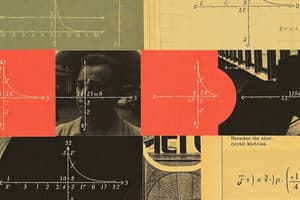Podcast
Questions and Answers
What happens to the set of solutions S if all coefficients ai are zero and b is nonzero?
What happens to the set of solutions S if all coefficients ai are zero and b is nonzero?
- S is an infinite set.
- S contains only the origin.
- S includes all points in Rn.
- S is empty. (correct)
If a system of linear equations has at least one nonzero ai, what form will the solution set take?
If a system of linear equations has at least one nonzero ai, what form will the solution set take?
- S is a finite set of points.
- S is a single point.
- S is an infinite set. (correct)
- S is empty.
What geometrical representation do the equations of a system of two linear equations in two variables form?
What geometrical representation do the equations of a system of two linear equations in two variables form?
- A single line.
- Two lines. (correct)
- Two planes.
- An area in R2.
What is the role of back substitution in solving linear equations?
What is the role of back substitution in solving linear equations?
In the context of a system of linear equations, what is the significance of RREF?
In the context of a system of linear equations, what is the significance of RREF?
When applying Gaussian elimination, what is the first step taken?
When applying Gaussian elimination, what is the first step taken?
Which of the following statements is true about a system of linear equations that has no solution?
Which of the following statements is true about a system of linear equations that has no solution?
What does solving the linear equation $2x + 3y = 1$ geometrically yield?
What does solving the linear equation $2x + 3y = 1$ geometrically yield?
What is the unique solution of the linear equation $ax = b$ when $a \neq 0$?
What is the unique solution of the linear equation $ax = b$ when $a \neq 0$?
If the equation $ax + by = c$ has the coefficients $a = b = c = 0$, what can be said about the solutions?
If the equation $ax + by = c$ has the coefficients $a = b = c = 0$, what can be said about the solutions?
What does the set of solutions for the equation $ax + by + cz = d$ represent when at least one of $a$, $b$, or $c$ is nonzero?
What does the set of solutions for the equation $ax + by + cz = d$ represent when at least one of $a$, $b$, or $c$ is nonzero?
When applying Gauss-Jordan elimination, what form should the matrix be transformed into?
When applying Gauss-Jordan elimination, what form should the matrix be transformed into?
Which of the following statements about systems of linear equations is correct?
Which of the following statements about systems of linear equations is correct?
What is the role of back substitution in solving linear systems?
What is the role of back substitution in solving linear systems?
What outcome occurs when all coefficients $a$, $b$, and $c$ of the three-variable linear equation $ax + by + cz = d$ are zero but $d$ is not zero?
What outcome occurs when all coefficients $a$, $b$, and $c$ of the three-variable linear equation $ax + by + cz = d$ are zero but $d$ is not zero?
Which method is traditionally used to systematically solve a system of linear equations?
Which method is traditionally used to systematically solve a system of linear equations?
Which of the following best describes a nontrivial solution in a homogeneous system of linear equations?
Which of the following best describes a nontrivial solution in a homogeneous system of linear equations?
What is the primary characteristic of a homogeneous system of linear equations?
What is the primary characteristic of a homogeneous system of linear equations?
What is the purpose of the back substitution method in solving linear equations?
What is the purpose of the back substitution method in solving linear equations?
Under which condition can a system of linear equations have infinite solutions?
Under which condition can a system of linear equations have infinite solutions?
In the context of matrices, what does an m × n matrix represent?
In the context of matrices, what does an m × n matrix represent?
Which statement is true regarding the Gauss-Jordan elimination method?
Which statement is true regarding the Gauss-Jordan elimination method?
What does the Reduced Row Echelon Form (RREF) of a matrix ensure?
What does the Reduced Row Echelon Form (RREF) of a matrix ensure?
If X1 and X2 are two distinct solutions of a system, what can be deduced about any linear combination involving these solutions?
If X1 and X2 are two distinct solutions of a system, what can be deduced about any linear combination involving these solutions?
Flashcards are hidden until you start studying
Study Notes
Linear Equations
- A linear equation in n variables is expressed as: ( a_1 x_1 + a_2 x_2 + ... + a_n x_n = b ).
- Coefficients ( a_i ) and constant ( b ) are real numbers.
- Solutions are n-tuples or vectors ((s_1, s_2, ..., s_n) \in \mathbb{R}^n) that satisfy the equation.
Unique Solutions in One Variable
- For a linear equation ( ax = b ):
- If ( a \neq 0 ), then there is a unique solution: ( x = \frac{b}{a} ).
- If ( a = 0 ) and ( b \neq 0 ), there is no solution.
- If ( a = 0 ) and ( b = 0 ), all real numbers are solutions.
Linear Equations in Two Variables
- The general form in two variables is ( ax + by = c ):
- If ( a = b = c = 0 ), all pairs ((s_1, s_2) \in \mathbb{R}^2) are solutions (infinite solutions).
- If ( a = b = 0 ) but ( c \neq 0 ), there are no solutions.
- If at least one of ( a ) or ( b ) is nonzero, the solutions form a straight line in (\mathbb{R}^2) (infinite solutions).
Linear Equations in Three Variables
- In three variables represented as ( ax + by + cz = d ):
- If ( a = b = c = 0 ) and ( d \neq 0 ), the solution set is empty.
- If ( a = b = c = d = 0 ), all points in (\mathbb{R}^3) are solutions.
- If at least one of ( a, b, c ) is nonzero, the solutions can be represented on a plane in (\mathbb{R}^3).
System of Linear Equations
- A system consists of two linear equations:
- ( a_1 x + b_1 y = c_1 ) and ( a_2 x + b_2 y = c_2 ).
- A solution is an ordered pair ((s_1, s_2) \in \mathbb{R}^2) that satisfies both equations simultaneously.
- The set of solutions is defined as:
- ( S = {(s_1, s_2) \in \mathbb{R}^2 : a_1 s_1 + b_1 s_2 = c_1 \text{ and } a_2 s_1 + b_2 s_2 = c_2} ).
Methods for Solving Linear Systems
- Geometrical method: Solutions of equations correspond to lines in the plane.
- Trivial solution: The zero vector for homogeneous equations; nontrivial solutions are any solutions other than the zero vector.
Exercises
- Solve the provided equations to find sets of solutions:
- Simple linear equations like ( 3x = 2 ) and ( 2x + 3y = 1 ).
- Use graphical method, Cramer's rule, and variable elimination to solve systems of equations.
Properties of Solutions
- Nontrivial solutions indicate infinitely many solutions in homogeneous systems.
- If ( X_1 ) and ( X_2 ) are distinct solutions, the linear combination ( X_1 + c(X_1 - X_2) ) remains a solution.
Matrices
- A matrix is a rectangular array of numbers organized in rows and columns.
- The order of a matrix is defined as ( m \times n ) where ( m ) is the number of rows and ( n ) is the number of columns.
Studying That Suits You
Use AI to generate personalized quizzes and flashcards to suit your learning preferences.




